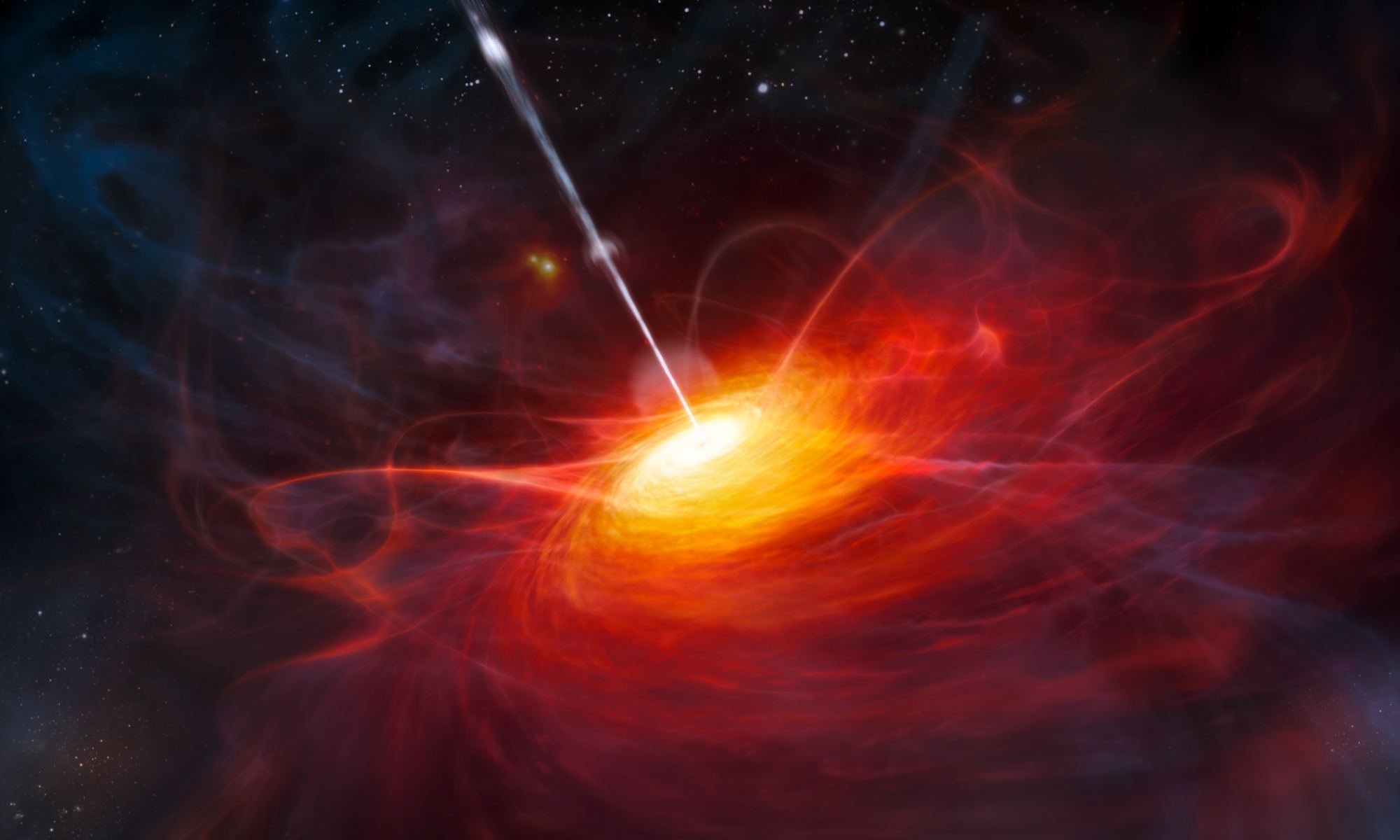When you look at most galaxies in the Universe, you’re looking at the homes of supermassive black holes. It now appears that quasars, which are active galaxies spitting out huge amounts of radiation from the region around their black holes, also have massive dark matter halos. It turns out they’ve always had them. And, their black hole activity has a direct connection with those halos.
How can the presence of dark matter around quasars spur such activity? This question prompted Nobunari Kashikawa from the University of Tokyo to survey hundreds of these objects in the early Universe. He and his team found that they seem to be activated by the presence of dark matter halos (DMH) and that the behavior is consistent throughout cosmic history.
“We measured for the first time the typical mass for dark matter halos surrounding an active black hole in the universe about 13 billion years ago,” said Kashikawa. “We find the DMH mass of quasars is pretty constant at about 10 trillion times the mass of our Sun. Such measurements have been made for more recent DMH around quasars, and those measurements are strikingly similar to what we see for more ancient quasars. This is interesting because it suggests there is a characteristic DMH mass which seems to activate a quasar, regardless of whether it happened billions of years ago or right now.”

Quasar Feeding Frenzy
We know that supermassive black holes can be voracious eaters. Their own galaxies supply much of their sustenance, funneling it in through central bars or other mechanisms. But, dark matter’s gravitational influence also sends matter into the maw of the black hole. The more dark matter there is, then, the greater the feeding cycle. A typical quasar emits a tremendous amount of energy—by some estimates upwards of 1040 watts. That would require at least 10 solar masses of material each year. The brightest ones eat upwards of a thousand solar masses to sustain their prodigious output.
It’s important to remember that the black hole itself isn’t radiating the energy. That comes from activity in the accretion disk. Material that gets funneled into the black hole gets heated, and eventually, it’s hot enough to begin emitting radiation. That includes visible light, ultraviolet, and radio waves. Some material escapes through a jet controlled by strong magnetic fields. Those jets and strong emissions are the principal signals of a quasar.
Observing Quasars
So, another question is: Do quasars do this throughout history? And, what’s the correlation between DMH mass and energetic activity? To find the answers, Kashikawa’s team began their surveys in 2016. They used the Subaru Telescope in Hawai’i and other instruments to look at 107 quasars at a redshift of z~6 (about 12.7 billion light-years away). They found that the DMH mass remained fairly constant throughout the surveyed population.
This confirms earlier studies that the related halo masses remain constant up to about z~4 (in quasars as they appeared about 12 billion years ago). The team came to several other conclusions. First, most quasars exist inside dark halos that have about 1012.5 to 1013 solar masses. (That mass is separate from the black hole mass and the stellar masses.) Second, there’s a characteristic halo mass that plays a role in activating the supermassive central black hole to create the quasar.

Measuring DHM masses isn’t exactly easy. First, dark matter itself is hard to observe. It’s detectable through its gravitational impact on galaxies. It affects their motions and movement. It also exists in smaller accumulations, which astronomers are still working to understand. Another way to detect the effect of dark matter is through gravitational lensing. Dark matter’s gravitational pull can deflect or distort light from more distant objects. Astronomers can deduce how much exists by the distortions. At larger distances (such as the distances to the quasars in Kashikawa’s study) astronomers have to deal with redshifted light and other challenges.
What’s Next?
Quasars give astronomers a leg up on understanding their DHM masses because quasars are very bright in all regimes of the electromagnetic spectrum. Modern techniques using spectroscopy allow astronomers to measure the galaxies and their dark matter halos in more detail.
Clearly, more studies of quasars at different redshifts will be made to confirm the DMH masses. The team is using Subaru’s HyperSuprimeCam to study quasars at z~5 (as they existed about 12.4 billion years ago). They also cite additional measurements to be made by the Atacama Large Millimeter Array in Chile that will allow them to compare halo masses to the stellar masses in the host galaxy. JWST will also allow more direct measurements of host galaxy stellar populations and masses. In the future, the Nancy Grace Roman and Euclid observatories (both slated for launch within the decade) could deliver larger sample sizes of quasars across a wider range of the Universe.
All these measurements will help sort out the mass of the host galaxy quasars from their supermassive black holes and their dark matter halos. Ultimately, the findings will help astronomers understand how these galaxies and their supermassive black holes co-evolved alongside their dark matter halos in the early Universe.
For More Information
Dark Matter Halos Measured Around Ancient Quasars
Subaru High-z Exploration of Low-Luminosity Quasars (SHELLQs). XVIII. The Dark Matter Halo Mass of Quasars at z~6

